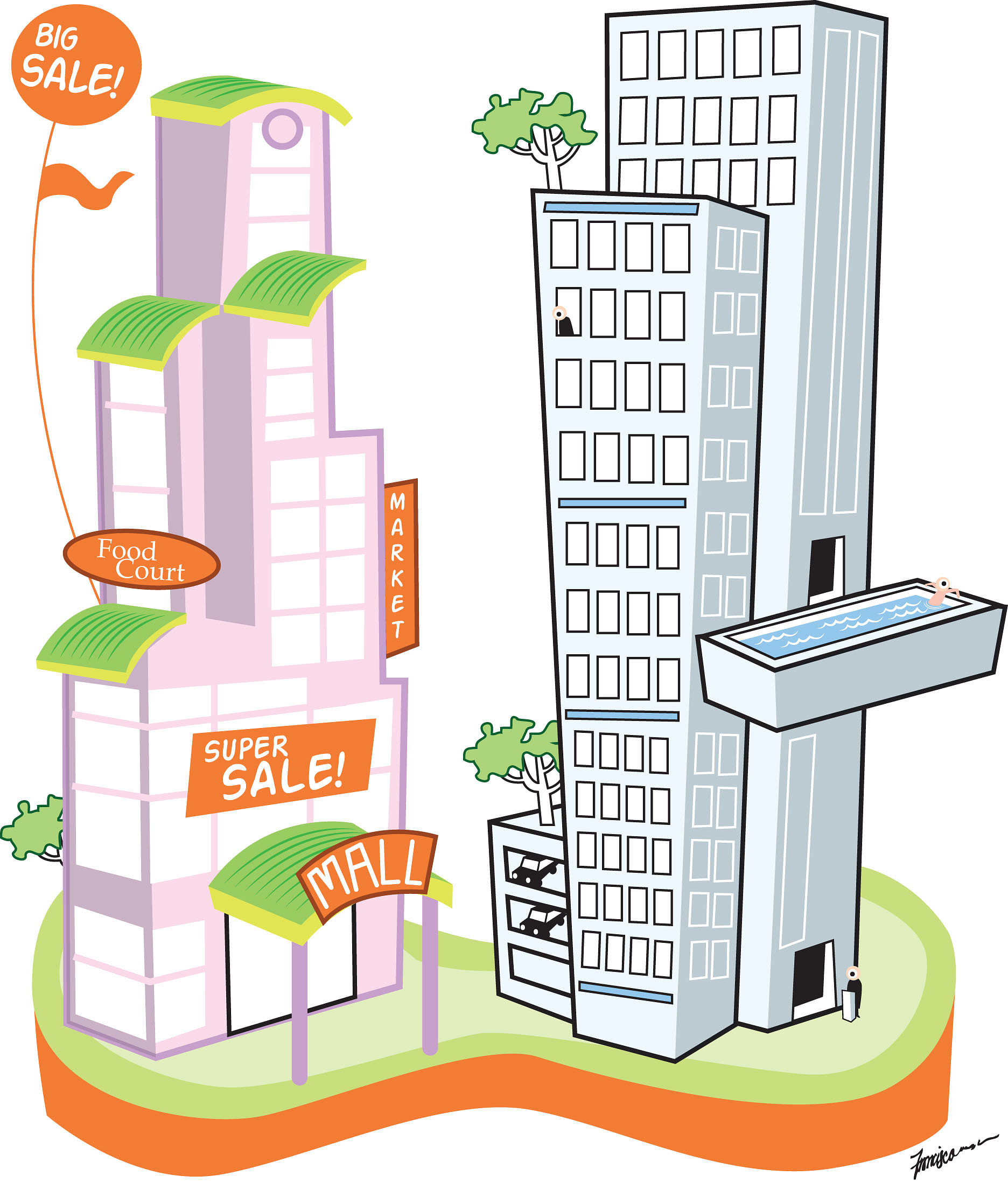One-North Residences in Buona Vista is a condominium but its outdoor plaza and the retail outlets on the ground floors of its residential blocks - which include a minimart and cafeteria - are open to the public.
A mix of low gating and transparent barriers gives the public a glimpse into the green spaces within, while lift lobbies to homes, pools and a gym can be accessed only by using a card.
The condominium, which was completed in 2009, offers a foretaste of what Singaporeans could see in three up-and-coming neighbourhoods.
On Monday, Minister for National Development Lawrence Wong announced that about 19,000 home units would be launched in the future in Kampong Bugis, Holland Plain and Bayshore.
The first two will be private residential areas, while Bayshore will contain a mix of public and private housing.
Said Mr Wong: "In Kampong Bugis, we are looking to introduce more porosity in the design of the precinct to make it a more open and inclusive neighbourhood. For example, the traditional fences you see in private condominiums can be replaced by softer boundaries, so that the overall area looks more open and accessible.
"More commercial and community facilities can also be introduced on the ground floors of the residential blocks so that they can be easily accessed not just by residents, but also members of the public. We are exploring similar concepts in the Holland Plain precinct."
This "open" concept holds out the promise of a slew of benefits such as a stronger sense of community and a more efficient use of space in a country where land is in short supply.

But how ready and receptive might Singaporeans be to the idea of more inclusive private housing, given the price difference between public and private residences, and the way notions of privacy and exclusivity have long been used to brand the latter as a more desirable lifestyle choice?
WELL-CONNECTED
As part of the Government's push towards a car-lite society, proposals for Kampong Bugis, Holland Plain and Bayshore include pedestrian-and cyclist-friendly features, such as public pathways, courtyards and amenities.
The three new neighbourhoods will enjoy parks and green spaces linked to islandwide networks such as the Rail Corridor, Round Island Route and East Coast Park.
A master developer will be appointed for the 17ha Kampong Bugis, which will be launched in one to two years' time. The 60ha Bayshore area, next to East Coast Park, will be launched after 2024 and have a 1km main street that is lined with trees, shops, cafes and parks, and linked to a network of courtyards in residential blocks.
The planning concepts proposed for the three areas, Mr Wong said, "can be scaled and adapted all over Singapore".
Some developers and sociologists have welcomed the proposals.
Mr Cheng Hsing Yao, group managing director of GuocoLand Singapore, welcomed the idea of condominiums that do not look like "fortresses", yet remain secure and well-connected. "If your condominium provides some pathways, and a neighbouring condominium provides a shortcut, then (those could join together) and you also benefit as a resident. If you live in a gated private estate, you have to skirt around other people's properties to get where you want."
He added that a push for more walkable, open designs across a new, large precinct would be more successful at promoting community spirit than one involving only a single development.
"It is important for the Government to take the initiative. It requires the whole neighbourhood to be sharing the same idea," he said.
Fenceless apartment blocks are prevalent in some of the most expensive cities in the world, such as high-density New York City and land-scarce Hong Kong. In Singapore, mixed-use developments such as Bedok Residences, integrated with Bedok Mall downstairs, have met with some success.
Associate Professor Ho Kong Chong, from the National University of Singapore's department of sociology, said having a more open concept is a step in the right direction.
"If you ask me, do I want that kind of totally fenced-off (property) with a small garden shared by condo users, or one with a larger, but open garden, I'd take the latter because that allows me to enjoy a more generous open space. As long as there's no congestion, it shouldn't be an issue."
OPEN, YET EXCLUSIVE?
Yet concerns about privacy and security remain. The price difference between private and public housing means residents might feel they are not getting the exclusivity they think they are entitled to, even though the condominium's residential areas and private amenities are closed to the public.
ERA Realty's key executive officer Eugene Lim said the idea of a more "open" design concept would put people off, since an "enclosed environment" is what typically separates private from public housing.
The introduction of more "open and inclusive" private residential estates might ironically result in greater public demand for older, gated developments, he said.
Mr Lim added: "It would attract a niche group of people. If you are buying to rent your unit out, I think (privacy) would be less of a concern."
Mr Liam Wee Sin, deputy group chief executive officer of UOL Group, one of the developers of One-North Residences, said adopting an open concept would have to be "case-specific". He said that not having a conventional boundary fence worked well in the Buona Vista development because it is nestled in a peaceful neighbourhood.
Indeed, residents The Straits Times spoke to said that if One-North Residences fronted a main road or had more human traffic, they would expect tighter security.
Architectural barriers that could make developments seem open - yet keep them private - include hedges, water features or ha-ha walls, which are sunken ditches that create a barrier between two land areas while ensuring an unbroken view. Raintree Gardens, which UOL Group is redeveloping, will be launched next year with a terraced landscape along the boundary facing the Kallang River. Private amenities will be on the upper floors.
But it remains to be seen to what extent a more open aesthetic, combined with innovative attempts to promote walkability and introduce communal spaces, would foster greater community spirit.
When The Straits Times visited One-North Residences' plaza on a Sunday, the space was quiet, save for a few cyclists and people visiting the minimart. Mr Michael Ryan, owner of the plaza's Jimmy Monkey cafe, pointed out: "There's no reason for people to come out here and interact unless there's something to do."
It is one thing to have more communal spaces, and another altogether to exploit their full potential through ground-up events - such as flea markets or local interest groups - where people can interact.
And while a more "open" aesthetic might offer tantalising views of the green, private spaces inside a condominium, this might make non-residents more acutely aware of what they are not able to access.
Furthermore, NUS' Prof Ho said that people are unlikely to interact spontaneously with those they do not already know. Citing the Housing Board's 2013 Sample Household Survey, he also pointed out that they are also less likely to bump into people they do know at coffee shops, markets and parks - as opposed to amenities that draw a smaller pool of people who make frequent repeat visits.
"When people meet their neighbours, you can see that most encounters occur around the lift and common area close to the flat," he added.
AGE OF CHOICE
These days, people's spheres of social interaction extend far beyond their local neighbourhood. Physical proximity is no longer a prerequisite for forming or sustaining friendships, and the need to connect with one's local community is less pressing.
People can join virtual communities of like-minded people, playing chess not with their neighbours at void decks, but with someone halfway across the world. In this era of choice, how close do they want, or even need, to be to their physical neighbours?
Prof Ho proposes a radical idea for condominiums in the future: "I'd like to see a society where all you buy is a furnished apartment."
Such a property, secured with card access, would be located near public transport nodes and come without the usual amenities such as swimming pools, gyms, or even carparks. Home owners would pay less for these flats, and can use public facilities elsewhere or join clubs for their specific interests.
But the very idea of an "open" neighbourhood itself could attract people bound by similar ideals about communal living. These areas could take on their own unique character, suggested Dr Chua Yang Liang, former urban planner at the Urban Redevelopment Authority and head of research and strategy at ARA Private Funds.
So will the "kampung" in Kampong Bugis be more than just a buzzword? How successful will innovative designs be in promoting a neighbourhood that is more open, not just physically, but also mentally?
It is still early days. The success of these new precincts could result in them being held up as models for future neighbourhoods. And then, with time, those psychological fences might start to come down.

